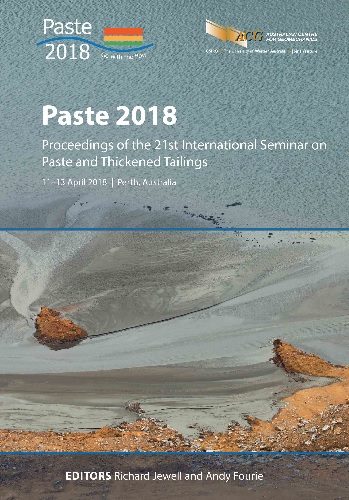A conceptual cost comparison of alternative tailings disposal strategies in Western Australia

|
Authors: Carneiro, A; Fourie, AB |
DOI https://doi.org/10.36487/ACG_rep/1805_36_Carneiro
Cite As:
Carneiro, A & Fourie, AB 2018, 'A conceptual cost comparison of alternative tailings disposal strategies in Western Australia', in RJ Jewell & AB Fourie (eds), Paste 2018: Proceedings of the 21st International Seminar on Paste and Thickened Tailings, Australian Centre for Geomechanics, Perth, pp. 439-454, https://doi.org/10.36487/ACG_rep/1805_36_Carneiro
Abstract:
Increasing regulatory and social demands are key driving forces behind operational changes taking place in mining. As tailings storage facilities (TSFs) come under scrutiny, operators are looking at alternative tailings management strategies. Integrated tailings management, including technical, economic, environmental, social, and risk aspects of the operation is urgently required. Current evaluation methodologies used to decide on the preferred method are limited, and have often poorly addressed the issue of realistic financial provisioning for the responsible disposal of tailings. The use of high-density tailings may be the best available option in many cases. However, it is often deemed undesirable because of economics – a conclusion that sometimes results from short-term profit-based assessments. Furthermore, there is a recognised lack of information on the costs of dewatering technologies to aid in tailings management decision-making. This paper reports on an economic evaluation completed for comparing the lifecycle costs of disposing a typical non-acid generating gold tailings in the Goldfields of Western Australia. Conceptual TSF designs were developed and costed for managing the tailings as slurry, thickened, and filtered. Key elements driving the costs of disposal are highlighted and discussed. The concepts of the West Australian Mining Rehabilitation Fund (MRF) are introduced and considered in the estimates. In the context of increasing tailings management challenges, changes in the lifecycle costs over a range of possible future case scenarios are presented within the results to evaluate to what extent different TSF designs and closure strategies have on driving the costs of disposal in the long-term. The paper ends with a discussion addressing the long-standing challenges of financially quantifying the ‘real’ costs of surface tailings disposal. An appropriate comparison depends on the assessment of the accumulated costs resulting from a more holistic approach. This serves to enable decision makers to decide on the best practice for tailings disposal efficiency to ensure sound environmental and social performance.
Keywords: tailings management, cost comparison, tailings storage facility design, Mining Rehabilitation Fund
References:
Business Queensland, Queensland Government 2017, Mining Financial Assurance Calculator, viewed 15 February 2018,
Carneiro, A & Fourie, AB 2017, ‘Economic evaluation for the disposal of slurry versus thickened tailings in Western Australia – A case study’, in GW Wilson, DC Sego and NA Beier (eds), Proceedings of the Twenty-first International Conference on Tailings and Mine Waste, University of Alberta Geotechnical Centre, Edmonton, pp. 138–149.
Espinoza, RD & Morris, JWF 2016, ‘Towards sustainable mining (part II): accounting for mine reclamation and post reclamation care liabilities’,
Fitton, TG & Roshdieh, A 2013, ‘Filtered tailings versus thickened slurry: four case studies’, in RJ Jewell, AB Fourie, J Caldwell and J Pimenta (eds), Proceedings of the 16th International Seminar on Paste and Thickened Tailings, Australian Centre for Geomechanics, Perth, pp. 275–288.
Johnson, D, Moghaddam, R, Bin Ahmed, I & Laroche, C 2013, ‘Comparative evaluation of surface disposal of thickened versus slurry tailings’, in RJ Jewell, AB Fourie, J Caldwell and J Pimenta (eds), Proceedings of the 16th International Seminar on Paste and Thickened Tailings, Australian Centre for Geomechanics, Perth, pp. 289–302.
State of New South Wales and Department of Planning and Environment, 2017 Rehabilitation Cost Estimation Tool, viewed 1 February 2018,
The Australasian Institute of Mining and Metallurgy 2012, Cost Estimation Handbook, 2nd edn, Monograph 27, The Australasian Institute of Mining and Metallurgy, Melbourne.
© Copyright 2025, Australian Centre for Geomechanics (ACG), The University of Western Australia. All rights reserved.
View copyright/legal information
Please direct any queries or error reports to repository-acg@uwa.edu.au
View copyright/legal information
Please direct any queries or error reports to repository-acg@uwa.edu.au



